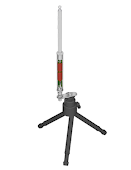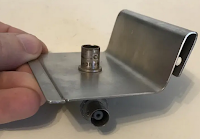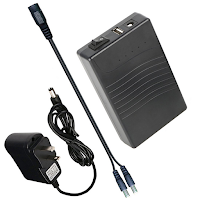 |
Elecraft AX1 With Tripod
|
Introduction:
Are you someone who loves to go portable with your amateur radio
equipment? If so, you know that having a reliable antenna system is crucial to
communicate with other ham radio operators.
The Elecraft AX1 antenna system is a
popular choice when it comes to portability. One way to set up the AX1 which may get better results is to use a window mount with your antenna.
In this article, we will
explain why a homemade car window mount for the Elecraft AX1 antenna system might be a good choice and how to mount the Elecraft AX1 Antenna System on a car window.
Benefits of the AX1 Window Mount:
One benefit of a homemade car window mount is improving both receive and transmit signals. The Elecraft AX1 is an omnidirectional antenna which will send and receive
signals from all directions. One way to help maximize signals from and to the antenna is by mounting the AX1 outside the car window. Using a few techniques you can maximize signals to and from the Elecraft AX1 Antenna System.
A homemade car window mount
allows you to position the AX1 in a way that will reduce interference from nearby objects and eliminate your body capacitance. A window mount will also improve outgoing signals as most of the antenna will be above the roofline of the car.
Another advantage is that it is easy to install. You can
create your own mount using simple materials like a double BNC connector and about 12 inches of 4 inch wide bar stock. This means you can easily install and
remove the mount as needed, allowing you to take your mount wherever you go.
 |
| W2AEW's AX1 Window Mount |
A Homebrew AX1 Window Mount:
Creating your own homemade car window mount is also
cost-effective. Buying a commercial MFJ-310 window mount for your antenna system can be a bit expensive, but with just a few simple materials, you can create a sturdy and
reliable mount that will improve your radio experience.
Lastly, properly designing your own sturdy homemade car window mount will ensure that the
mount is properly attached and will reducing the risk of antenna damage.
If you prefer, you can use a commercial window mount (Affiliate Link) instead
of a homemade one. Perhaps you have some scrap metal around, then creating your own mount can be a cost-effective and
fun DIY project. A homemade car window mount should be lightweight and be designed to avoid damaging the trim and car window.
Conclusion:
In summary, a homemade car window mount for the Elecraft AX1
antenna system is a another fun accessory for QRP ham radio operators who enjoy going portable with
their QRP equipment.
A window mount is easy to install, cost-effective, and increases signal
reception and transmissions. Don't let poor signal reception or expensive commercial
mounts hold you back. With a little creativity and effort, you can build a
sturdy and reliable mount that will improve your radio experience on the go. So
why not give it a try? Go through your junk box and get busy creating your own AX1 window mount.
KE2YK's Notes:
As an Elecraft AX1 user let me just say that the window mount accessory is another QRP treat! I'm here to offer you some tips for maximizing the performance of the Elecraft AX1 Antenna System on a car window mount.
First things first, take your time to securely fasten the mount to your car window before attaching the antenna. I cannot stress this enough. A wobbly or unstable mount can not only affect the performance of your antenna but may damage your vehicle. So, double-check everything before you start calling CQ.
Once your mount is in place, remember to optimize the counterpoise for the band you are going to operate. The KX line of transceivers have awesome ATU's but getting the SWR in the ballpark is important when working QRP. Don't be afraid to experiment with different mounting locations on your vehicle until you find the sweet spot that works best for you. As always, the key to optimal performance lies in fine-tuning.
So, my friend, with these tips in mind, you're all set to explore the benefits of using a car window mount with the Elecraft AX1 Antenna System. Trust me; it's a world of its own up there in the airwaves, and you're in for another QRP adventure!
Who is KE2YK:
Gary Utz (KE2YK) is an amateur radio operator and blogger based in New York, USA. He is the author of the blog ke2yk.com and qrpshack.blogspot.com, which focuses on amateur radio topics such as antenna building, radio contests, and equipment reviews. Gary has been a licensed amateur radio operator for more than 30 years and is an active member of the amateur radio community. On his blog, he shares his experiences and insights about the hobby, as well as tips and advice for other amateur radio enthusiasts.
Here's a List of AX1 Resources:
Resource [1] describes how to mount the
AX1 on a window bracket and connect it using a 25 foot length of RG-174 cable.
Resource [2] features a story about
using the AX1 with a tripod and running coax out the window for digital
activations. Resource [3] talks about using the AX1
with a Hamstick and car roof mag mount combo for a successful activation.
72 de KE2YK
Related Posts:
How To Build A Cheap Tilt Over Tower

















